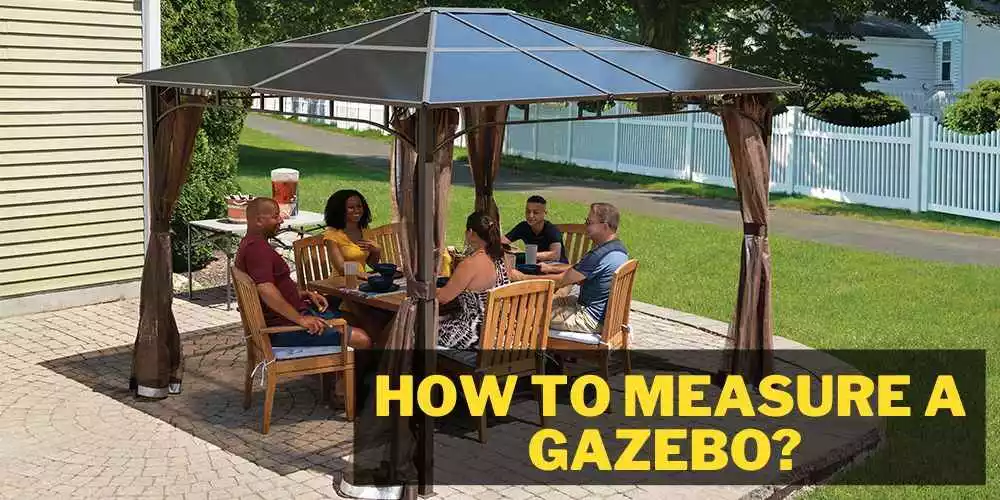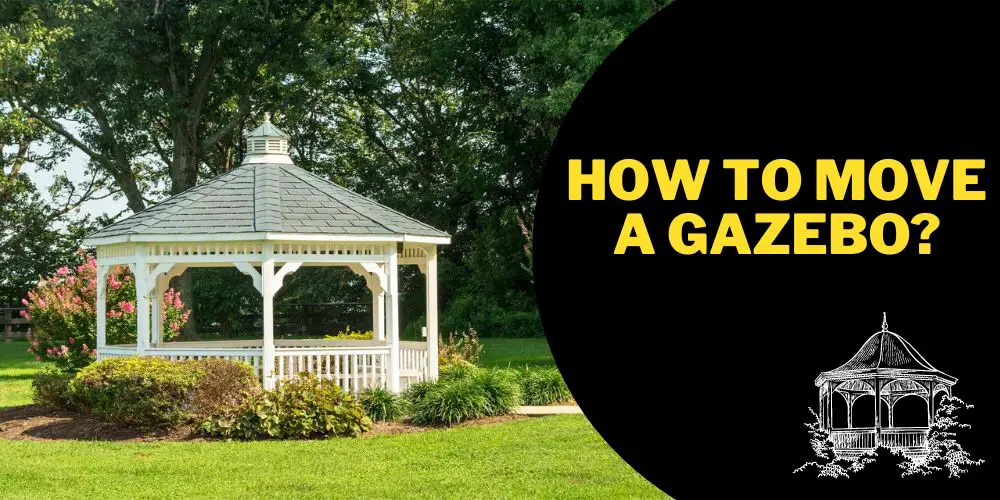A gazebo is more than just a decorative garden structure; it’s a tranquil retreat that invites you to enjoy the outdoors. But what happens when rain cascades off its roof, turning everything beneath into a soggy mess? That’s where gutters come in. These simple devices channel water away, preventing damage and maintaining the gazebo’s integrity.
But can you put gutters on a gazebo? And if so, how? This article will explore the feasibility of installing gutters on a gazebo, exploring the types, benefits, and challenges. Whether you’re worried about water damage, aesthetics, or simply making the most of your gazebo, we’ll guide you through the solutions to put those concerns to rest.
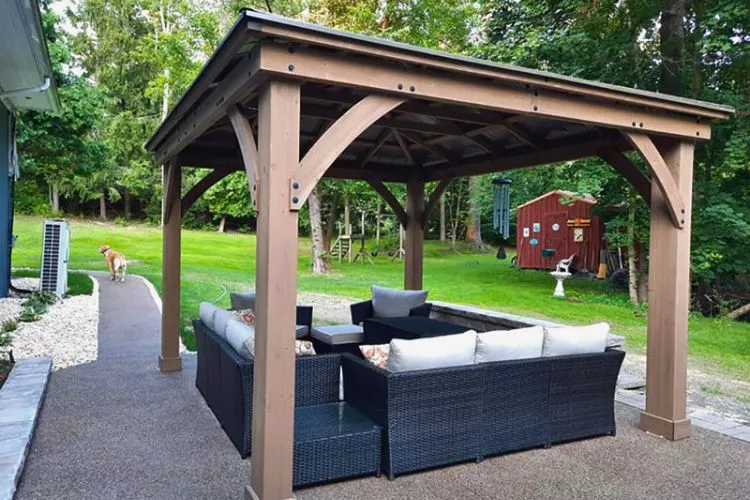
Can You Put Gutters on a Gazebo?
The straightforward answer to putting gutters on a gazebo is yes, you can. But as with many architectural decisions, it’s not merely about the possibility but how it’s done.
Gutters can be installed on a gazebo to divert rainwater, preserving the structure and surrounding landscape. However, the feasibility depends on various factors, including the gazebo’s design, materials, roof slope, and local weather conditions.
For instance, a flat-roofed gazebo might require careful planning for water drainage, while a sloped roof might facilitate a more conventional gutter installation. The materials of the gazebo, whether wood, metal, or vinyl, also influence the choice of gutters, as compatibility is key to aesthetics and functionality.
In summary, installing gutters on a gazebo is not only feasible but often advisable to prolong the structure’s life and enhance the space’s enjoyment. However, careful consideration of design, materials, and environmental factors is essential for successful integration. Professional guidance or meticulous DIY planning can help you achieve the desired outcome without compromising the gazebo’s beauty or integrity.
Understanding Gutters and Gazebo Structures?
Before we dive into installing gutters on a gazebo, it’s essential to understand the fundamentals of both gutters and gazebo structures. This understanding lays the foundation for determining compatibility, integration, and the methods that can be used for installation.
In the following section, we’ll explore the different types of gutters, common gazebo materials, and designs and how they relate, setting the stage for our in-depth examination.
What Are Gutters?
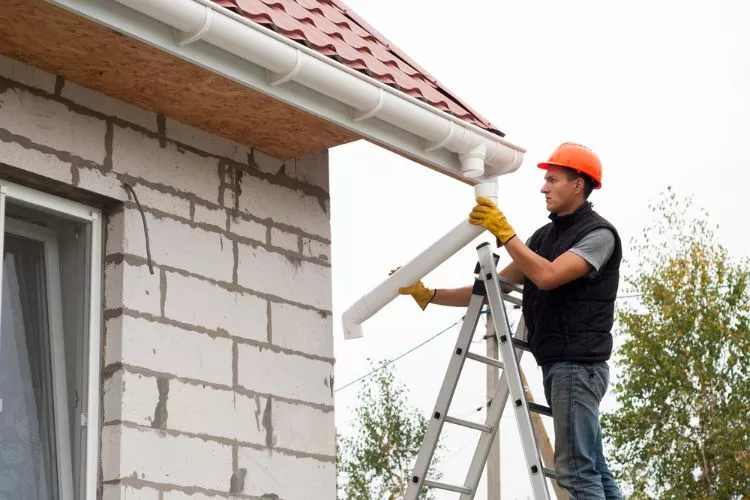
Gutters are channels that collect and divert rainwater from a building’s structure. They prevent water from pooling on roofs, protect the foundation, and mitigate soil erosion around a property.
Gutters are typically installed along the roof’s edge and connected to downspouts that guide water away.
They can be made from various materials with unique characteristics and benefits, fitting different architectural styles and environmental conditions.
Types of Gutters
Understanding the different types of gutters is key to finding the right fit for a gazebo. Here’s a brief overview:
- PVC gutters: Affordable and easy to install, PVC gutters are lightweight and rust-resistant. They are an excellent choice for durable durability without breaking the bank.
- Metal gutters: Metal gutters are known for their strength and longevity, including materials such as aluminum, copper, and steel. They can be customized to match the aesthetics of a gazebo.
- Flexible gutters: These are designed for unconventional or unique structures. Flexible gutters can bend and conform to the shape of the roof, providing tailored water drainage solutions.
Choosing the right type of gutter involves considering factors like the gazebo’s design, the local climate, and personal preferences.
What Is a Gazebo?
A gazebo is an open-sided structure often found in gardens, parks, or other outdoor spaces. Equipped with a roof and often a raised floor, it provides shelter and a scenic spot to enjoy the surrounding nature.
Gazebos are used for various purposes, such as hosting outdoor gatherings, creating a peaceful reading nook, or simply adding architectural charm to a landscape.
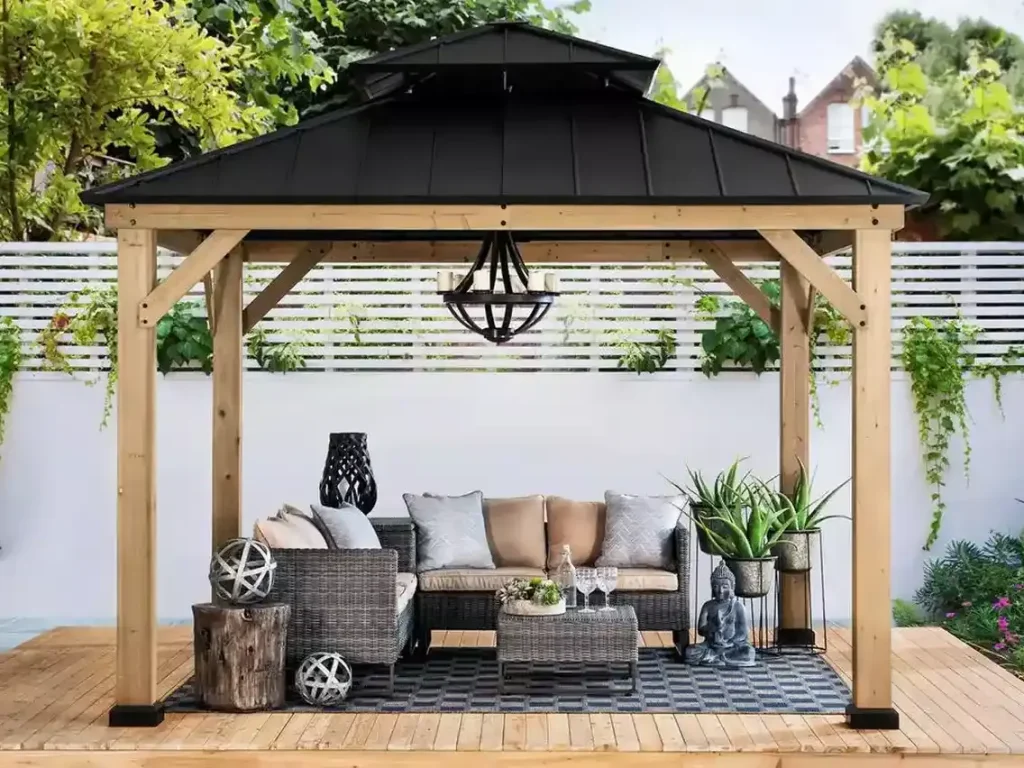
They come in different shapes, including octagonal, hexagonal, or rectangular, and can be temporary or permanent fixtures.
Common Gazebo Materials and Designs
The materials and designs of a gazebo vary widely, catering to different tastes, budgets, and functional needs. Here’s an insight into some common options:
- Wooden Gazebos: Crafted from woods like cedar or redwood, these gazebos offer a classic, natural look. They are durable but require regular maintenance to prevent weather-related wear.
- Metal Gazebos: Often made from wrought iron, aluminum, or steel, metal gazebos are sturdy and long-lasting. They may be designed with intricate patterns for a touch of elegance.
- Vinyl Gazebos: For those seeking low maintenance without sacrificing style, vinyl gazebos are an excellent choice. They resist rot and can mimic the appearance of wood.
- Thatched Roof Gazebos: These gazebos have roofs made from organic materials like straw or reeds. They create a rustic, tropical ambiance suitable for certain landscape themes.
Understanding the specific nature of gazebos and the materials involved is crucial when considering the addition of gutters. This knowledge ensures that the chosen gutters complement the gazebo’s structure and aesthetics while fulfilling their functional role.
Why to Put Gutters on a Gazebo?
Installing gutters on a gazebo is a thoughtful addition that offers several practical benefits. Let’s explore these reasons in more depth:

Protecting the Gazebo Structure
Rainwater falling directly off the roof can erode the soil around the gazebo’s base or even splash against the lower walls. This constant exposure can weaken the foundation and cause wood to rot or metals to corrode. Gutters act as a shield, channeling the water away and ensuring the gazebo’s structural integrity for years to come.
Preventing Water Damage
Water splashing back onto the gazebo can stain wooden surfaces and cause premature wear and tear. Gutters eliminate this issue by capturing the rainwater and directing it to downspouts. This simple yet effective method can greatly extend the lifespan of the gazebo’s materials, saving you both time and money on potential repairs or replacements.
Preserving Landscaping and Surrounding Areas
A steady flow of rainwater from the roof can wash away soil, harm delicate plants, and even create muddy patches around the gazebo. Gutters provide controlled water flow, allowing you to direct it to specific areas or even into rain barrels. This protects the beauty and health of the surrounding landscape and prevents unsightly erosion.
Enhancing Comfort and Utility
Gutters enhance the comfort of the gazebo by preventing water from dripping down the sides during rain. This keeps the interior and perimeter dry, allowing you to enjoy the space in various weather conditions. Whether hosting a gathering or seeking solace with a book, gutters help make your gazebo a year-round retreat.
Eco-Friendly Water Collection
Gutters offer an eco-conscious benefit by allowing for rainwater harvesting. Connecting the downspouts to rain barrels provides free water for gardening or other outdoor tasks. This promotes water conservation and can reduce utility bills, aligning with sustainable living practices.
Challenges and Considerations
While installing gutters on a gazebo offers numerous benefits, it’s not without complexities. From design considerations to material compatibility, specific challenges must be addressed to ensure a successful installation.
This section will delve into the intricacies of fitting gutters to a gazebo, highlighting the essential aspects to consider and potential hurdles to overcome. Understanding these elements can help craft a well-informed strategy, ensuring that the gutters function effectively and blend seamlessly with the gazebo’s aesthetics.
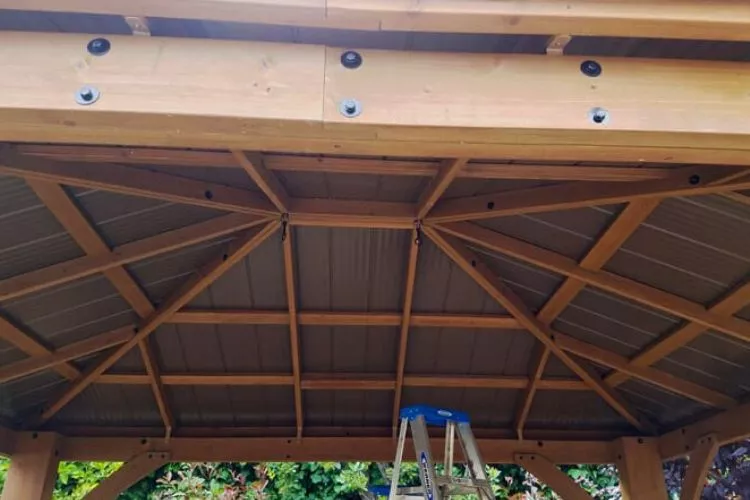
Gazebo Design and Integration
Gazebo design plays a crucial role in the integration of gutters. The roof’s shape, slope, and overall architecture must be considered to ensure that gutters fit seamlessly. For example, a traditional pitched roof might accommodate standard gutters easily, while a more complex or ornate design may require custom solutions.
Moreover, the way gutters are integrated can significantly impact the appearance of the gazebo. If not thoughtfully implemented, gutters might detract from the aesthetic appeal. Careful planning and design adaptation can preserve visual harmony, making the gutters a discreet yet functional addition.
Material Compatibility
Selecting the right materials for the gutters is pivotal in achieving a successful installation. Gutters come in various materials, such as PVC, metal, and aluminum, and the choice should align with the gazebo’s existing structure.
For example, if the gazebo is made of wood, using a material that complements the wood’s color and texture will create a more cohesive look. Conversely, mismatched materials can lead to a discordant appearance and may cause functional issues, like corrosion, if incompatible metals are used together.
Proper Drainage and Slope
The effectiveness of gutters on a gazebo depends on proper drainage and slope. The gutters must be installed at a precise angle to allow water to flow toward the downspouts without pooling. An incorrect slope can lead to water stagnation, which may cause leakage, overflow, or even breeding grounds for mosquitoes.
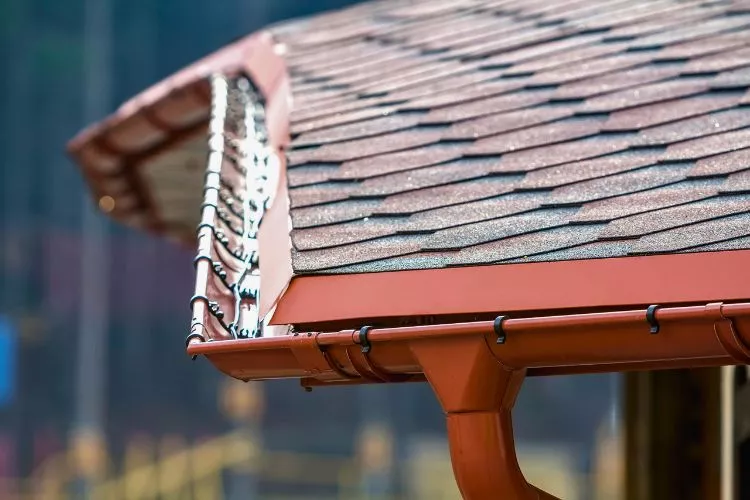
The slope must also be considered in harmony with the design of the gazebo, ensuring that it doesn’t compromise the visual appeal. This balance between function and form may require careful calculation or professional guidance.
Gutter Size and Capacity
Choosing the right size and capacity for the gutters is another essential consideration. Too small, and the gutters may overflow during heavy rain; too large, and they may look disproportionately bulky on the gazebo.
The roof’s surface area and the average rainfall in your region should determine the size. Understanding these factors helps select gutters that can handle the water volume without being excessively large.
Capacity is about the gutters, downspouts, and the entire drainage system. Ensuring that all components are harmoniously sized guarantees that the water is efficiently channeled away from the gazebo, preserving its integrity and appearance.
Steps to Install Gutters on a Gazebo
Installing gutters on a gazebo is a project that calls for careful planning and precise execution. Whether you’re a DIY enthusiast or simply want to understand the process before hiring professionals, knowing the essential steps can guide you toward a successful installation.
From assessing the gazebo’s structure to selecting the right gutters and making final adjustments, this section will outline a step-by-step approach to installing gutters. By understanding these fundamental steps, you can ensure that the gutters enhance the aesthetics and perform optimally, safeguarding your gazebo for years to come.

Assessing Gazebo Structure and Measurements
Before embarking on the installation, a thorough assessment of the gazebo’s structure and measurements is paramount. Analyzing the shape, slope, and size of the roof helps determine the type and design of gutters that would be the best fit.
Measurements should be taken with accuracy, noting the roof’s length, width, and angles. To ensure precision, use imperial (feet, inches) and metric (meters, centimeters) measurements. Consider the materials used in the gazebo’s construction, which may influence the type of fasteners or brackets you’ll need.
Moreover, understanding the existing design can help preserve the gazebo’s architectural integrity, ensuring that the gutters enhance rather than detract from its appearance.
Selecting Suitable Gutters
Once the structure has been assessed, the next step is selecting suitable gutters. This involves choosing the right material, size, shape, and style that complements the gazebo.
- Material Options: Whether it’s PVC, metal, or flexible gutters, the choice should align with the gazebo’s aesthetic and the climatic conditions of your area.
- Size Consideration: Select a size that ensures efficient drainage depending on the roof’s surface area and regional rainfall patterns.
- Shape and Style: Gutters come in various shapes, such as K-style or half-round. Choosing one that matches the gazebo’s design enhances visual harmony.
Consider consulting a professional or a specialized retailer, as they can offer insights into the latest gutter technology and materials that might suit your gazebo.
Combining an accurate assessment of the gazebo with a thoughtful selection of gutters lays a strong foundation for a successful installation. These initial steps are crucial in ensuring that the gutters will function effectively and blend seamlessly with the gazebo’s structure.
Gutter Placement and Attachment Options
Gutter placement is a nuanced step that requires attention to both functional needs and aesthetic considerations. The attachment method must be chosen wisely, considering the gazebo’s material and design.
- Gutter Brackets and Hangers: These should be spaced appropriately (e.g., every 24 inches or 61 cm) to provide sufficient support.
- Slope Consideration: Ensure a gradual slope towards the downspouts for proper drainage.
- Attachment Methods: Depending on the gazebo’s structure, you may use screws, nails, or special clips. Remember to check material compatibility to prevent corrosion.
The goal is to achieve a secure attachment that aligns with the gazebo’s design, providing functionality and visual appeal.
Joining Gutters and Downspouts
The connection between gutters and downspouts is vital for efficient water channeling. Care must be taken to ensure leak-proof connections.
- Measure and Cut: Accurate measurements are essential to cut the gutters and downspouts to fit perfectly.
- Seal Joints: Utilize high-quality sealants compatible with the gutter material to prevent leaks at the joints.
- Positioning Downspouts: Position downspouts in discreet locations, considering function and aesthetics.
Joining gutters and downspouts properly prevents water damage and maintains the integrity of the gazebo.
Testing and Adjustments
Once installed, testing the gutters ensures they are functioning as intended. This includes:
- Water Flow Test: Pour water into the gutters and observe how it flows towards the downspouts, checking for proper slope and drainage.
- Inspect for Leaks: Carefully look at the joints and seals to detect any leaks that may need additional sealing.
- Make Adjustments: If needed, adjust the slope, positioning, or attachment methods to optimize performance.
Don’t hesitate to make necessary tweaks; fine-tuning ensures the gutters work efficiently and look appealing.
Pro Tips for Installing Gutters on a Gazebo
Installing gutters on a gazebo is a nuanced task. While following the standard steps is essential, a few professional tips can elevate your gutter installation to the next level. These insights aim at enhancing the gutters’ performance and contributing to the overall longevity and visual appeal of your gazebo.
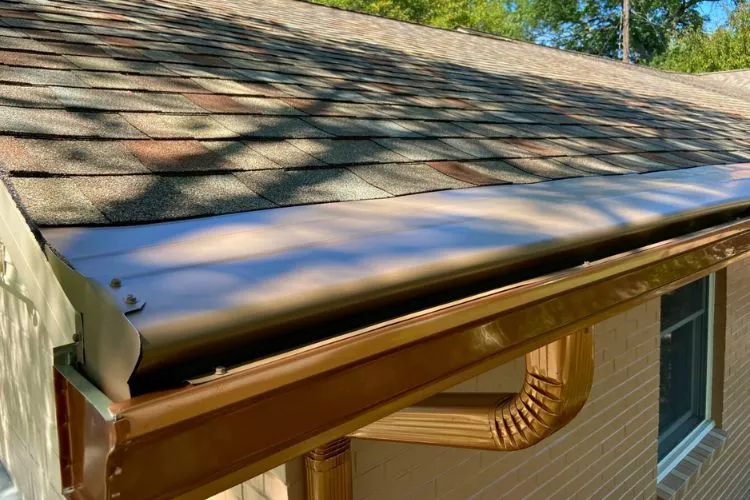
Regular Maintenance for Longevity
Just like any other aspect of your home, gutters on a gazebo require regular maintenance to ensure longevity:
- Cleaning: Periodic removal of leaves, twigs, and other debris to prevent clogs.
- Inspection: Check for signs of wear, corrosion, or loose fastenings.
- Repairs: Prompt attention to any damage or wear ensures that small issues don’t escalate into major problems.
- Measures in Both Imperial and Metric: Maintain a schedule using regular intervals (e.g., every 6 months or 182.88 cm).
By attending to your gutters regularly, you ensure they effectively protect your gazebo for years.
Using Gutter Guards to Prevent Clogging
Clogs can hinder water flow and lead to problems. Installing gutter guards is a wise preventive measure:
- Select Suitable Guards: Choose guards that match your gutter type and size.
- Installation: Proper installation is crucial for effectiveness. Follow the manufacturer’s instructions.
- Monitor Performance: Even with guards, periodic checking ensures they work as intended.
Gutter guards are an invaluable tool in preserving the efficiency of your gutters and preventing unwanted clogging.
Disguising Gutters for Aesthetics
Your gazebo’s visual appeal doesn’t have to be compromised by the gutters. Consider these tips to disguise them:
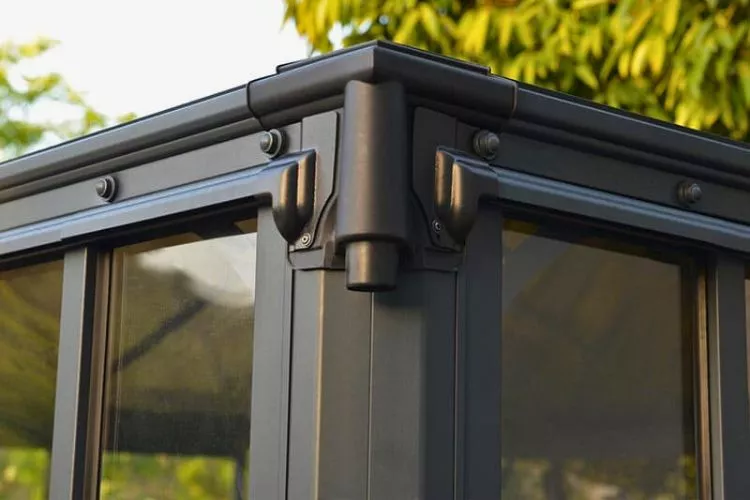
- Color Matching: Choose gutters that match or complement the gazebo’s color scheme.
- Decorative Brackets: Utilize brackets that add a decorative touch.
- Integration with Design: Align gutters with other architectural elements to create a harmonious appearance.
Aesthetic integration ensures that gutters add to rather than detract from your gazebo’s beauty.
Consulting a Professional if Unsure
While many aspects of gutter installation can be handled DIY, don’t hesitate to consult a professional if you’re unsure:
- Expert Guidance: Professionals can provide valuable insights tailored to your specific gazebo.
- Quality Assurance: Utilizing professional services often comes with guarantees and can ensure top-notch installation.
Incorporating professional insights can take your gutter installation from good to great. These pro tips, gleaned from years of experience, can make the difference between a standard gutter installation and one that excels in function and form. By adopting these practices, you create a system that safeguards your gazebo from water damage and fits seamlessly into its aesthetic design.
You May Also Want To Know: Can a gazebo withstand heavy rain? | Best Gazebo For Wind and Rain | Are Gazebos Waterproof?
Frequently Asked Questions (FAQs)
Can all types of gazebos have gutters installed?
Most gazebos can install gutters, depending on the design and materials. Consulting with a professional is advised for unconventional structures.
What materials are best for gutter installation on a gazebo?
PVC, aluminum, and galvanized steel are popular for gazebo gutters, balancing durability and aesthetics.
Do I need to hire a professional to install gutters on a gazebo?
Hiring a professional ensures proper installation but is not mandatory. With proper tools and guidelines, DIY installation is feasible.
How do I ensure the gutters don’t detract from the gazebo’s appearance?
Select gutters that match the gazebo’s color and style, and consider aesthetic integration like decorative brackets.
Can gutters help with mosquito and pest control around the gazebo?
Yes, gutters prevent standing water, reducing breeding grounds for mosquitoes and pests near the gazebo.
Conclusion:
Installing gutters on a gazebo provides essential protection for the structure and surrounding areas, enhancing its lifespan and aesthetics. The success of this installation hinges on the proper selection of materials, careful design integration, and regular maintenance. The benefits are maximized through meticulous attention to each step of the process, ensuring the gazebo remains a beautiful and functional focal point in your outdoor space. We hope that this guide has been helpful and answered your question: can you put gutters on a gazebo? You can read about similar topics here on our website. Check back again soon for more.

